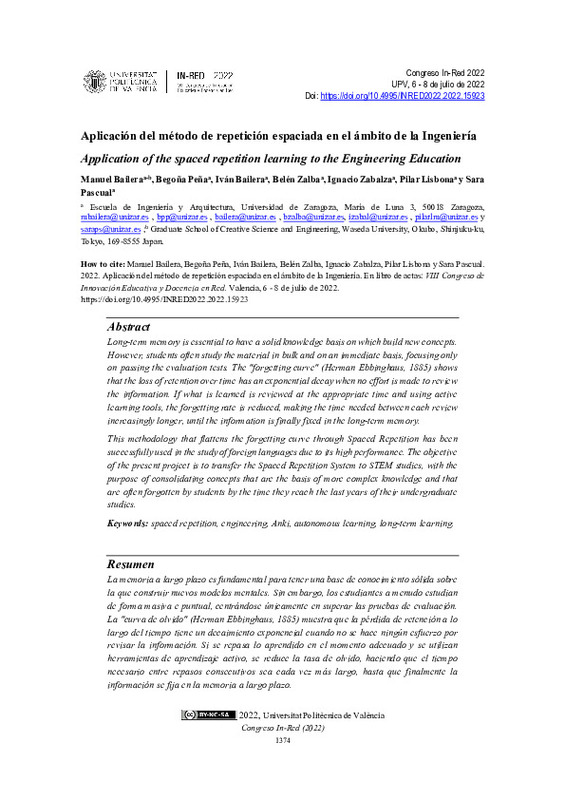JavaScript is disabled for your browser. Some features of this site may not work without it.
Buscar en RiuNet
Listar
Mi cuenta
Estadísticas
Ayuda RiuNet
Admin. UPV
Aplicación del método de repetición espaciada en el ámbito de la Ingeniería
Mostrar el registro sencillo del ítem
Ficheros en el ítem
| dc.contributor.author | Bailera, Manuel
|
es_ES |
| dc.contributor.author | Peña, Begoña
|
es_ES |
| dc.contributor.author | Bailera, Iván
|
es_ES |
| dc.contributor.author | Zalba, Belén
|
es_ES |
| dc.contributor.author | Zabalza, Ignacio
|
es_ES |
| dc.contributor.author | Lisbona, Pilar
|
es_ES |
| dc.contributor.author | Pascual, Sara
|
es_ES |
| dc.date.accessioned | 2022-11-29T10:47:26Z | |
| dc.date.available | 2022-11-29T10:47:26Z | |
| dc.date.issued | 2022-10-28 | |
| dc.identifier.isbn | 9788413960173 | |
| dc.identifier.uri | http://hdl.handle.net/10251/190316 | |
| dc.description.abstract | [EN] Long-term memory is essential to have a solid knowledge basis on which build new concepts. However, students often study the material in bulk and on an immediate basis, focusing only on passing the evaluation tests. The "forgetting curve" (Herman Ebbinghaus, 1885) shows that the loss of retention over time has an exponential decay when no effort is made to review the information. If what is learned is reviewed at the appropriate time and using active learning tools, the forgetting rate is reduced, making the time needed between each review increasingly longer, until the information is finally fixed in the long-term memory. This methodology that flattens the forgetting curve through Spaced Repetition has been successfully used in the study of foreign languages due to its high performance. The objective of the present project is to transfer the Spaced Repetition System to STEM studies, with the purpose of consolidating concepts that are the basis of more complex knowledge and that are often forgotten by students by the time they reach the last years of their undergraduate studies. | es_ES |
| dc.description.abstract | [ES] La memoria a largo plazo es fundamental para tener una base de conocimiento sólida sobre la que construir nuevos modelos mentales. Sin embargo, los estudiantes a menudo estudian de forma masiva e inmediata, centrándose únicamente en superar las pruebas de evaluación. La "curva de olvido" (Herman Ebbinghaus, 1885) muestra que la pérdida de retención a lo largo del tiempo tiene un decaimiento exponencial cuando no se hace ningún esfuerzo por revisar la información. Si se repasa lo aprendido en el momento adecuado y se utilizan herramientas de aprendizaje activo, se reduce la tasa de olvido, haciendo que el tiempo necesario entre repasos consecutivos sea cada vez más largo, hasta que finalmente la información se fija en la memoria a largo plazo.Esta metodología que aplana la curva de olvido a través de la Repetición Espaciada se ha utilizado con éxito en el estudio de lenguas extranjeras debido a su alto rendimiento. El trabajo aquí presentado tiene como objetivo trasladar el Sistema de Repetición Espaciada a los estudios STEM, con el propósito de consolidar conceptos que son la base de conocimientos más complejos y que muchas veces los estudiantes han olvidado cuando llegan a los últimos cursos de sus estudios universitarios. | es_ES |
| dc.description.sponsorship | Este trabajo ha sido financiado por medio de los proyectos PIIDUZ_21_125 y PIIDUZ_21_305 pertenecientes al Programa de Proyectos de Innovación Docente del Vicerrectorado de Política Académica de la Universidad de Zaragoza. | es_ES |
| dc.format.extent | 11 | es_ES |
| dc.language | Español | es_ES |
| dc.publisher | Editorial Universitat Politècnica de València | es_ES |
| dc.relation.ispartof | In-Red 2022 - VIII Congreso Nacional de Innovación Educativa y Docencia en Red | |
| dc.rights | Reconocimiento - No comercial - Compartir igual (by-nc-sa) | es_ES |
| dc.subject | Spaced repetition | es_ES |
| dc.subject | Engineering | es_ES |
| dc.subject | Anki | es_ES |
| dc.subject | Autonomous learning | es_ES |
| dc.subject | Long-term learning | es_ES |
| dc.subject | Repetición espaciada | es_ES |
| dc.subject | Ingeniería | es_ES |
| dc.subject | Aprendizaje autónomo | es_ES |
| dc.subject | Aprendizaje a largo plazo | es_ES |
| dc.title | Aplicación del método de repetición espaciada en el ámbito de la Ingeniería | es_ES |
| dc.title.alternative | Application of the spaced repetition learning to the Engineering Education | es_ES |
| dc.type | Capítulo de libro | es_ES |
| dc.type | Comunicación en congreso | es_ES |
| dc.identifier.doi | 10.4995/INRED2022.2022.15923 | |
| dc.relation.projectID | info:eu-repo/grantAgreement/UNIZAR//PIIDUZ_21_125 | es_ES |
| dc.relation.projectID | info:eu-repo/grantAgreement/UNIZAR//PIIDUZ_21_305 | es_ES |
| dc.rights.accessRights | Abierto | es_ES |
| dc.description.bibliographicCitation | Bailera, M.; Peña, B.; Bailera, I.; Zalba, B.; Zabalza, I.; Lisbona, P.; Pascual, S. (2022). Aplicación del método de repetición espaciada en el ámbito de la Ingeniería. En In-Red 2022 - VIII Congreso Nacional de Innovación Educativa y Docencia en Red. Editorial Universitat Politècnica de València. 1374-1384. https://doi.org/10.4995/INRED2022.2022.15923 | es_ES |
| dc.description.accrualMethod | OCS | es_ES |
| dc.relation.conferencename | IN-RED 2022: VIII Congreso de Innovación Educativa y Docencia en Red | es_ES |
| dc.relation.conferencedate | Julio 06-08, 2022 | es_ES |
| dc.relation.conferenceplace | Valencia, España | es_ES |
| dc.relation.publisherversion | http://ocs.editorial.upv.es/index.php/INRED/InRed2022/paper/view/15923 | es_ES |
| dc.description.upvformatpinicio | 1374 | es_ES |
| dc.description.upvformatpfin | 1384 | es_ES |
| dc.type.version | info:eu-repo/semantics/publishedVersion | es_ES |
| dc.relation.pasarela | OCS\15923 | es_ES |
| dc.contributor.funder | Universidad de Zaragoza | es_ES |








